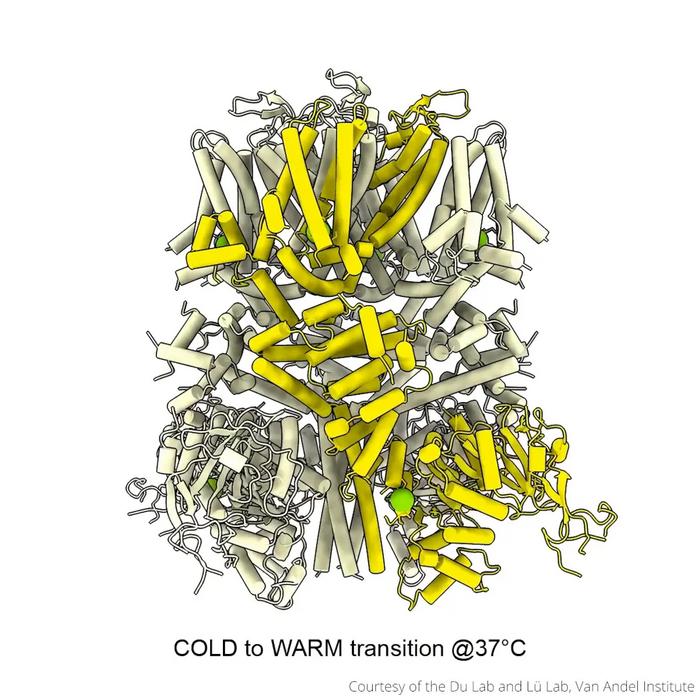GRAND RAPIDS, Mich. (May 15, 2024) — Some proteins shift their shape when exposed to different temperatures, revealing previously unknown binding sites for medications.

Credit: Du Lab and Lü Lab, Van Andel Institute
GRAND RAPIDS, Mich. (May 15, 2024) — Some proteins shift their shape when exposed to different temperatures, revealing previously unknown binding sites for medications.
The findings, published today in Nature, could revolutionize wide swathes of biology by fundamentally changing how protein structure is studied and leveraged for drug design. The study was led by Van Andel Institute’s Juan Du, Ph.D., and Wei Lü, Ph.D.
Proteins generally are investigated at low temperatures to ensure their stability. However, the new study demonstrates that certain proteins are highly sensitive to temperature and change their shape when viewed at body temperature.
“For a long time, the methods we’ve used to study proteins require them to be cold or frozen. But in the real world, human proteins exist and function at body temperature,” Du said. “Our study describes a new way to study proteins at body temperature and reveals that some proteins drastically alter their structures when warm, opening up new opportunities for structure-guided drug development.”
Proteins are the molecular workhorses of the body. Their shape governs how they interact with other molecules to do their jobs. By determining protein structure, scientists can create blueprints that guide development of more effective medications, much like locksmiths designing keys to fit into specific locks.
Although it is well known that temperature affects molecular function in the body, studying proteins at physiological temperature has been technologically challenging. Today’s study by the Du and Lü laboratories details how they overcame these issues and provides scientists a roadmap for doing so in their own experiments.
The study focused on a protein called TRPM4, which supports heart function and metabolism, including the release of insulin. As such, TRPM4 is linked to stroke, heart disease and diabetes, among other health conditions.
To visualize TRPM4 at body temperature, the team leveraged VAI’s powerful suite of cryo-electron microscopes (cryo-EM), which allow scientists to flash freeze proteins and assemble detailed images of their structures. Rather than using a low-temperature sample, Postdoctoral Fellow Jinhong Hu, Ph.D., and colleagues in the Du and Lü laboratories heated the sample to body temperature before flash freezing it. By doing so, they found that ligands — molecules that bind to proteins — interact with totally different sites on TRPM4 at body temperature than at lower temperatures.
The implications of today’s study are far-reaching and reinforce the importance of studying proteins at body temperature to ensure identification of physiologically relevant drug binding sites.
Other authors include Sung Jin Park, Ph.D., Tyler Walter, Ph.D., Ian J. Orozco, Ph.D., Garrett O’Dea and Xinyu Ye of VAI. The cryo-EM data was collected at VAI’s Cryo-EM Core and David Van Andel Cryo-Electron Microscopy Suite.
Research reported in this publication was supported by the National Heart, Lung and Blood Institute of the National Institutes of Health under award no. R01HL153219 (Lü); the National Institute of Neurological Disorders and Stroke of the National Institutes of Health under awards no. R01NS112363 (Lü), R01NS111031 (Du) and R01NS129804 (Du); a Klingenstein-Simons Fellowship Award in Neuroscience (Du); an Alfred P. Sloan Research Fellowship in Neuroscience (Du); a Pew Scholar in Biomedical Sciences from the Pew Charitable Trusts (Du); a McKnight Scholar Award (Du); and the American Heart Association under award no. 24POST1196982 (Hu). The content is solely the responsibility of the authors and does not necessarily represent the official views of the National Institutes of Health or other granting organizations.
###
ABOUT VAN ANDEL INSTITUTE
Van Andel Institute (VAI) is committed to improving the health and enhancing the lives of current and future generations through cutting edge biomedical research and innovative educational offerings. Established in Grand Rapids, Michigan, in 1996 by the Van Andel family, VAI is now home to more than 500 scientists, educators and support staff, who work with a growing number of national and international collaborators to foster discovery. The Institute’s scientists study the origins of cancer, Parkinson’s and other diseases and translate their findings into breakthrough prevention and treatment strategies. Our educators develop inquiry-based approaches for K–12 education to help students and teachers prepare the next generation of problem-solvers, while our Graduate School offers a rigorous, research-intensive Ph.D. program in molecular and cellular biology. Learn more at vai.org.
Journal
Nature
Method of Research
Experimental study
Article Title
Physiological temperature drives TRPM4 ligand recognition and gating
Article Publication Date
15-May-2024



